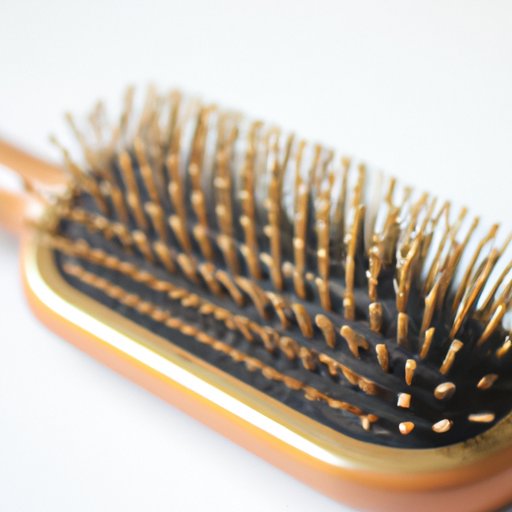
I. Introduction
Everyone wants healthy, shiny hair, but did you know that cleaning your hairbrush regularly can make a huge difference? Not only does it help maintain hygiene, but it also keeps your brush functioning at its best, which means your hair will look better too! In this article, we will explore the step-by-step process of cleaning a hairbrush, natural cleaning products, custom cleaning tools, alternate cleaning methods, the frequency of cleaning, and maintaining hairbrushes.
II. Step-by-Step Guide to Cleaning a Hairbrush
Before you begin, gather your tools: a bowl, a comb, a toothbrush, and liquid soap or shampoo. Start by removing any tangled hair from the brush. Then, soak it in a bowl filled with warm water and soap. Use a toothbrush to gently scrub the bristles and base of the brush to remove any dirt or residue. Rinse the brush thoroughly with warm water and let it dry completely. Cleaning techniques vary for different hair types; you may require special products or follow specific instructions, depending on your hair type and brush material.
III. Natural Cleaning Products
Using natural cleaning products is safer for both you and your brush. Vinegar, baking soda, and lemon juice are excellent natural alternatives to commercial cleaning solutions. For instance, mix one cup of water and one tablespoon of vinegar to soak your brush before scrubbing it using your toothbrush. You can also make a paste of baking soda and water and use it to clean your brush. These natural products are typically more effective than their commercial counterparts and chemical-free, making them a great alternative to harsh and toxic cleaning solutions.
IV. Frequency of Cleaning
How often you should clean your hairbrush depends on how often you use it. As a general rule, you should clean it at least once a week. However, if you use a lot of styling products or have oily hair, you should clean your brush more frequently. You should also replace your brush or its bristles every six months to avoid damage to your hair or scalp.
V. Custom Cleaning Tools
Customized cleaning tools, such as scissors, combs, and toothbrushes, can come in handy. Use your scissors to cut off strands of hair that are too tangled to remove gently using your fingers and comb. They are also great for detailed cleaning, such as getting rid of accumulated dirt in hard-to-reach areas. Use your comb to remove hair from your brush, particularly if it is a paddle brush. Toothbrushes can also be used for detailed cleaning and getting rid of buildup on the brush.
VI. Alternate Cleaning Methods
There are several alternate methods for cleaning your brush. Freezing your brush overnight will kill germs and bacteria. Boiling your brush in water for a few minutes is also another cleaning option. However, using extreme temperatures can cause damage to your brush over time, so it’s important to be careful.
VII. How to Maintain Hairbrushes
Maintaining your hairbrush is just as essential as cleaning it. After each use, remove any hair or loose bristles from the brush and store it in a clean, dry place. Avoid exposing your brush to high heat or long periods of sunlight, which can damage the bristles or the brush’s material. And most importantly, avoid being too rough with your brush. Brushing your hair too hard or in the wrong direction causes damage to your hair and the brush itself.
VIII. Conclusion
In conclusion, cleaning your hairbrush regularly is an essential part of your hair care routine. Use natural products when possible, and always remember to use customized tools and alternate methods correctly. Cleaning your brush frequently and storing it correctly will help you maintain its functionality and avoid damaging your hair or scalp.




